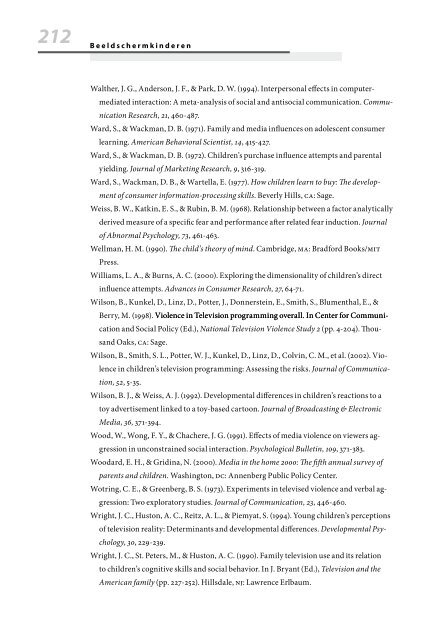Download PDF: Beeldschermkinderen - Kijkwijzer
Download PDF: Beeldschermkinderen - Kijkwijzer
Download PDF: Beeldschermkinderen - Kijkwijzer
Create successful ePaper yourself
Turn your PDF publications into a flip-book with our unique Google optimized e-Paper software.
212 <strong>Beeldschermkinderen</strong><br />
Walther, J. G., Anderson, J. F., & Park, D. W. (1994). Interpersonal effects in computer-<br />
mediated interaction: A meta-analysis of social and antisocial communication. Commu-<br />
nication Research, 21, 460-487.<br />
Ward, S., & Wackman, D. B. (1971). Family and media influences on adolescent consumer<br />
learning. American Behavioral Scientist, 14, 415-427.<br />
Ward, S., & Wackman, D. B. (1972). Children’s purchase influence attempts and parental<br />
yielding. Journal of Marketing Research, 9, 316-319.<br />
Ward, S., Wackman, D. B., & Wartella, E. (1977). How children learn to buy: The develop-<br />
ment of consumer information-processing skills. Beverly Hills, CA: Sage.<br />
Weiss, B. W., Katkin, E. S., & Rubin, B. M. (1968). Relationship between a factor analytically<br />
derived measure of a specific fear and performance after related fear induction. Journal<br />
of Abnormal Psychology, 73, 461-463.<br />
Wellman, H. M. (1990). The child’s theory of mind. Cambridge, MA: Bradford Books/MIT<br />
Press.<br />
Williams, L. A., & Burns, A. C. (2000). Exploring the dimensionality of children’s direct<br />
influence attempts. Advances in Consumer Research, 27, 64-71.<br />
Wilson, B., Kunkel, D., Linz, D., Potter, J., Donnerstein, E., Smith, S., Blumenthal, E., &<br />
Berry, M. (1998). Violence in Television programming overall. In Center for Communi-<br />
Communi-<br />
cation and Social Policy (Ed.), National Television Violence Study 2 (pp. 4-204). Thou-<br />
sand Oaks, CA: Sage.<br />
Wilson, B., Smith, S. L., Potter, W. J., Kunkel, D., Linz, D., Colvin, C. M., et al. (2002). Vio-<br />
lence in children’s television programming: Assessing the risks. Journal of Communica-<br />
tion, 52, 5-35.<br />
Wilson, B. J., & Weiss, A. J. (1992). Developmental differences in children’s reactions to a<br />
toy advertisement linked to a toy-based cartoon. Journal of Broadcasting & Electronic<br />
Media, 36, 371-394.<br />
Wood, W., Wong, F. Y., & Chachere, J. G. (1991). Effects of media violence on viewers ag-<br />
gression in unconstrained social interaction. Psychological Bulletin, 109, 371-383.<br />
Woodard, E. H., & Gridina, N. (2000). Media in the home 2000: The fifth annual survey of<br />
parents and children. Washington, DC: Annenberg Public Policy Center.<br />
Wotring, C. E., & Greenberg, B. S. (1973). Experiments in televised violence and verbal ag-<br />
gression: Two exploratory studies. Journal of Communication, 23, 446-460.<br />
Wright, J. C., Huston, A. C., Reitz, A. L., & Piemyat, S. (1994). Young children’s perceptions<br />
of television reality: Determinants and developmental differences. Developmental Psy-<br />
chology, 30, 229-239.<br />
Wright, J. C., St. Peters, M., & Huston, A. C. (1990). Family television use and its relation<br />
to children’s cognitive skills and social behavior. In J. Bryant (Ed.), Television and the<br />
American family (pp. 227-252). Hillsdale, NJ: Lawrence Erlbaum.







